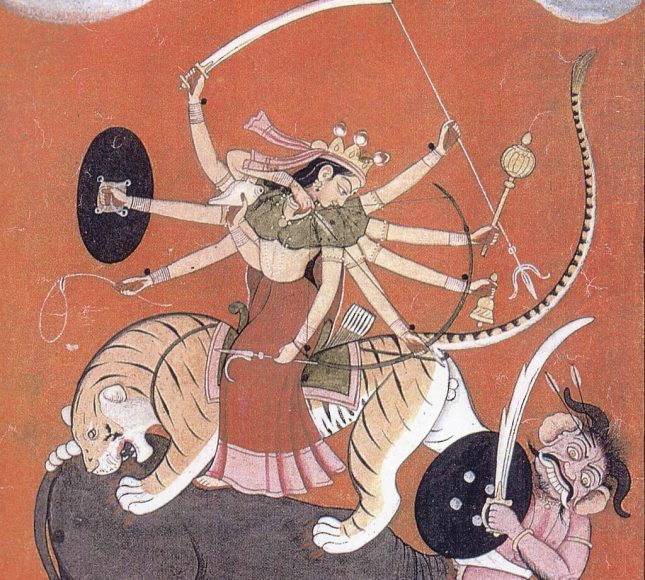DURGA Millions of Durgas massage the Lord. (Bhairo Kabir, p. 1162) Durga is the consort of Shiva. An account of her origin is found in \’Durga Saptshati\’ in Markandeya Purana. Mahishasura, the king of demons, at one time conquered the haughty gods in war. They went to Brahma and men to Shiva. But they could not help them. Then they went to Vishnu, who got enraged on seeing their pitiable plight.
From his extreme anger Durga or Maha Maya was born. The gods then gave their weapons to this newly-born goddess. With a frightful scream she ascended into the air and with great force attacked the demon-king and killed him. In Vaman Purana it is written that Vishnu gave her his discus, Shiva his trident, Varuna a conch-shell, Agni a dart, Vayu a bow, Surya a quiver full of arrows, Indra a thunderbolt, Kuvera a mace, Brahma a rosary and water-pot, Kala a shield and sword, Vishwakarma a battle-axe etc. Armed with these weapons, the goddess went to the Vindhya hills.
Chanda and Munda, the demon messengers saw her and captivated by her beauty, they described it to their king Mahisha. The demon-king asked for her hand, but she asked him to win her in fight. In the fight that followed Durga dismounted from her lion and jumped over the back of demon with buffalo-head and smote him with such force, that he fell senseless on the ground. Then she cut off his head with her sword. Durga has ten arms and her vehicle is a lion. She is said to have assumed ten forms for the destruction of two demon kings Sumbha and Nisumbha, the prominent of them being Kali, who drank the blood of Rakta-vija and did not let any drop to fall on the ground. See : Parbati (Parvati) and Maha-Mai
References :
1. Kohli, Surindar Singh (ed), Dictionary of Mythological References in Guru Granth Sahib, 1993
In Hindu mythology, Durga is one of the most revered goddesses, embodying strength, protection, and the triumph of good over evil. She is a principal form of the divine feminine energy, Shakti, and is often depicted as a warrior goddess riding a lion or tiger, wielding multiple weapons gifted by the gods. Her most famous legend is the slaying of the buffalo demon Mahishasura, a tale that symbolizes the victory of righteousness over malevolent forces. This story is celebrated during Durga Puja and Navaratri, festivals that honor her power and grace.
Durga is also associated with various forms, such as Chandi and Kali, each representing different aspects of the divine feminine. Texts like the Devi Mahatmya and Devi Bhagavata Purana extol her virtues and narrate her exploits. She is seen as a protector of the universe, a nurturer, and a destroyer of evil, embodying the cyclical nature of creation and destruction.
In the Guru Granth Sahib, Durga is referenced metaphorically, often symbolizing inner strength and wisdom. Sikh teachings use her story to illustrate the battle against inner vices and the importance of divine guidance. For instance, the Dasam Granth, attributed to Guru Gobind Singh, includes hymns like Chandi Charitar and Bhagauti Ki Vaar, which celebrate Durga’s valor and her role as a divine warrior. These texts reinterpret her as a symbol of spiritual power and resilience, aligning with Sikh principles of justice and righteousness.
Durga’s presence in both Hindu and Sikh traditions highlights her universal appeal as a symbol of empowerment and divine grace.






